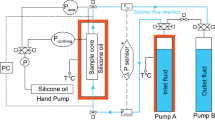Abstract
A working hypothesis, that MgCl2 solution brings about the magnesium metasomatism giving rise to the coarse grained magnesite deposits („Spatmagnesitlagerstätten“), was set up. The reaction CaMg(CO3)2 (Dolomite)+MgCl2 (dissolved)⇌ MgCO3 (Magnesite)+CaCl2 (dissolved), bearing on this process, was experimentally investigated. This reaction represents a case of trivariant equilibrium; the equilibrium temperature being determined by the following parameters: the fluid pressure, the total concentration of the dissolved salts and the Ca ∶ Mg ratio in the solution.
It was found that within the limits of the experimental conditions (P f=2000 bars, Temp.: 200–400° C), more magnesite is formed out of dolomite at higher temperature if the amount of MgCl2 is kept constant. For instance, for a total transformation of dolomite to magnesite at 200° C 2 1/2 times the amount of MgC12 is required as compared to the amount needed for the same reaction at 400° C. In other words, higher temperatures favour the formation of magnesite. The investigations carried out do not only explain the origin of magnesite from dolomite but also the reversed process of redolomitisation of magnesite.
Zusammenfassung
Es wurde die Arbeitshypothese entwickelt, daß die Mg-Metasomatose, die zur Bildung von Spatmagnesitlagerstätten führte, in chloridischer Lösung erfolgte. Deshalb wurde die Reaktion CaMg(CO3)2 (Dolomit)+MgCl2 (gelöst) ⇌MgCO3 (Magnesit)+CaCl2 (gelöst) experimentell untersucht. Dieses Reaktionsgleichgewicht ist trivariant; die Gleichgewichtstemperatur wird bestimmt durch den Druck der fluiden Phase, durch die Gesamtkonzentration an gelöstem Salz und durch das Ca-Mg-Verhältnis der Lösung.
Die Versuche haben ergeben, daß (im untersuchten Temperaturbereich von 200–400° C, P f=2000 Bar) bei einem bestimmten Angebot an MgCl2 bei höheren Temperaturen mehr Magnesit aus Dolomit gebildet wird als bei niedrigen. Um z.B. bei 200° C aus einer vorgegebenen Dolomitmenge quantitativ Magnesit zu bilden, wird das 2 1/2fache der Menge an MgCl2 benötigt, die bei 400° C für quantitative Magnesitbildung erforderlich ist. Hohe Temperaturen begünstigen also die Magnesitbildung. — Die durchgeführten Experimente vermögen nicht nur die Magnesitbildung aus Dolomit, sondern auch die Redolomitisierung von Magnesit gut zu erklären.
Similar content being viewed by others
Literatur
Angel, F., u. F. Trojer: Die Frage des Alters und der Genesis alpiner Spatmagnesite. Radex Rundschau 1955, 374–392.
Findlay, A.: Die Phasenregel und ihre Anwendung, 9. Aufl. Weinheim: Verlag Chemie GmbH 1958.
Franck, E. U., u. K. Tödheide: Thermische Eigenschaften überkritischer Mischungen von Kohlendioxyd und Wasser bis zu 750° C und 2000 Atm. Z. physik. Chem., N. F. 22, 232–245 (1959).
Sharp, W., and G. C. Kennedy: The system CaO-CO2-H2O in the two-phase-region calcite+aqueous solution. J. Petrol. 78, 391–403 (1965).
Usdowski, H. E.: Die Phasenbeziehungen der Systeme Ca2+-Mg2+-CO 2−3 -Cl 2−2 -SO 2−4 -H2Ound Na 2+;2 -Ca2+-Mg2+-CO 22− -SO 2−4 -H2O. Nachr. Akad. Wiss. Göttingen, Math.-physik. Kl. II, Nr. 20, 263–265 (1964).
— Die Genese von Dolomit in Sedimenten. (1966) (im Druck).
Winkler, H. G. F.: Die Genese der metamorphen Gesteine. Berlin-Heidelberg-New York: Springer 1965.
Author information
Authors and Affiliations
Additional information
Herrn Prof. Dr. H. G. F. Winkler danke ich herzlich für sein Interesse an dieser Arbeit und für wertvolle Kritik. Die benutzten Apparaturen wurden Herrn Prof. Winkler von der Deutsehen Forschungsgemeinschaft zur Verfügung gestellt. Für die Arbeitsmöglichkeit an diesen Apparaturen sei ebenfalls gedankt.
Rights and permissions
About this article
Cite this article
Johannes, W. Experimentelle Magnesitbildung aus Dolomit+MgCl2 . Contr. Mineral. and Petrol. 13, 51–58 (1966). https://doi.org/10.1007/BF00518126
Received:
Issue Date:
DOI: https://doi.org/10.1007/BF00518126




